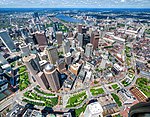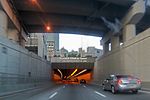Two International Place
1992 establishments in MassachusettsFinancial District, BostonJohn Burgee buildingsOffice buildings completed in 1992Philip Johnson buildings ... and 1 more
Skyscraper office buildings in Boston

Two International Place is a Postmodern skyscraper in the Financial District of Boston, Massachusetts. The site is located on a site formerly known as Fort Hill. It is located blocks from the North End, the waterfront, South Station, Downtown Crossing, and the Federal Courthouse. The building was designed by Johnson/Burgee Architects – whose principals are Philip Johnson and John Burgee – and completed in 1992. It is Boston's eleventh-tallest building, standing 538 feet (164 m) tall.
Excerpt from the Wikipedia article Two International Place (License: CC BY-SA 3.0, Authors, Images).Two International Place
High Street, Boston Downtown Boston
Geographical coordinates (GPS) Address External links Nearby Places Show on map
Geographical coordinates (GPS)
| Latitude | Longitude |
|---|---|
| N 42.356492 ° | E -71.051757 ° |
Address
Two International Place
High Street 2
02110 Boston, Downtown Boston
Massachusetts, United States
Open on Google Maps









